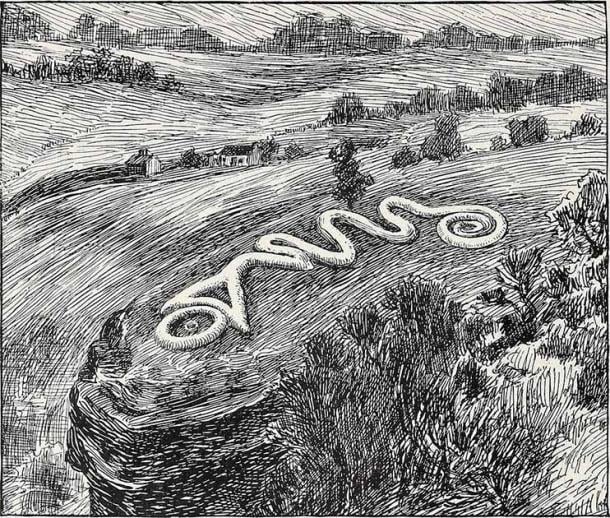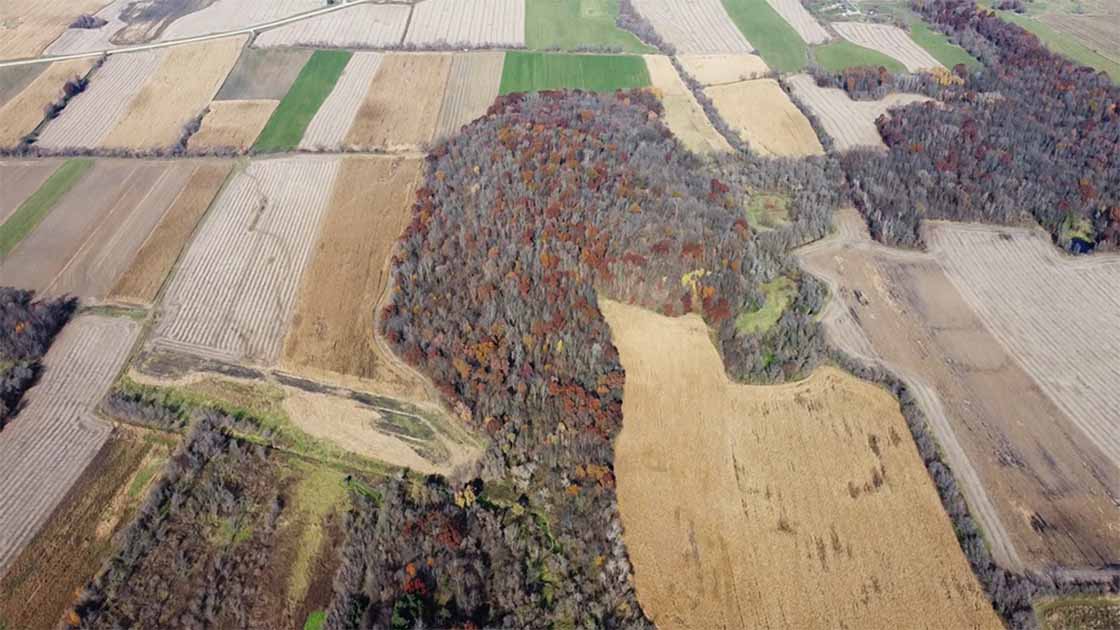Retired Historian Uncovers Native American Effigy Mounds in Wisconsin
In a patch of woods on a homestead in southeastern Wisconsin, a recent aerial survey revealed the presence of a pair of hidden historical gems. These were two Native American ceremonial (burial) mounds, which were constructed centuries ago by the indigenous Ho-Chunk people who occupied the region long before the first white settlers arrived. The effigy mounds were built in the shape of a panther and a tadpole, representing two animals that were sacred to the Ho-Chunk.
The area around the village of Lebanon in Dodge County was once covered with Native American burial mounds. Tragically, the vast majority of these astonishing man-made landscape features were destroyed in the 19th and 20th centuries by farmers more concerned with cultivating and harvesting their crops than preserving ancient earthen monuments.
But the destruction was not complete. Thousands of these effigy mounds still decorate the hills and valleys of Wisconsin, and even now new mounds are occasionally being discovered in surprising and unexpected locations. These two were discovered beneath a canopy of trees on a rural hillside outside of Lebanon, which was actually not that surprising since rumors had suggested there might be Native American effigy mounds at that location.

An effigy mounds commemorative quarter which depicts an aerial view of the mounds in the Marching Bear Group from Iowa’s Effigy Mounds National Monument. (Tom / Adobe Stock)
Finding the Hidden Effigy Mounds Shrouded by Trees
As a long-time resident of the Lebanon area, retired historian Chuck Werth had listened to stories claiming that the outlines of ancient effigy mounds had been spotted close to his property. “I heard the oral tradition that was preserved in one of the local families, that there were Indian mounds in these woods,” Werth told WKOW TV in Madison. “That was in the early 1990s.”
He didn’t dismiss these tales outright. But despite traversing the land many times he was never able to spot the slightest indication that any Native American effigy mounds might be found near his house.
- The Moundbuilders: North America’s Little-known Native Architects
- The Legends and Archaeology of Devil’s Lake: A Place of Ancient Power in Wisconsin
All of that changed this month, however, when Werth was using a drone to photograph and document historical buildings located throughout the Lebanon / Dodge County area. He eventually flew his drone over his own property, searching for signs of the long-rumored effigy mounds. His main focus was on a hill covered with dense trees displaying full fall colors, which had been identified as a likely spot where mounds might be found.
Examining the drone imagery carefully, he didn’t see proof of anything. But he posted his drone images online anyway, with an accompanying story explaining what he was searching for and asking for information from anyone who might have insights to share.
Werth’s photos of the forest-covered hills near his home, and his reports about the possibility of mounds being hidden there, piqued the interest of Dodge County Historical Society director Kurt Sampson. It was enough for Sampson to want to take action to verify the story. “Suddenly I get this phone call from Kurt Sampson, who is really Dodge County's premier expert on Native Americans and the mound builders, and he said, 'You're right, there are mounds there,'" Werth related.

Aerial view of the effigy mound found near Lebanon, Wisconsin, which depicts the tadpole and panther mounds identified using LiDAR technology. (Chuck Werth)
But How Could Sampson Be So Certain?
It was because he checked the hill site out for himself. He deployed a sophisticated aerial surveillance technology known as LiDAR (an acronym for light detection radar) to examine the hill from above. This laser-based technology has been responsible for the discovery of a number of archaeological ruins, in many locations throughout the world.
“What light detection radar does is, it strips away the vegetation, where all you see is the topography or the land, the landforms that are in an immediate area,” Sampson explained. “And because of that, the effigy shapes are so unique to the natural topographic surroundings, that they tend to pop right out.”
In this case, what the LiDAR system detected was the presence of two mounds in the shape of animals. These types of mounds have been given the “effigy” label. One of these animals was a tadpole, and the other a panther. This was most revealing, since these two animals are both considered sacred in Ho-Chunk lore.
Sampson’s current thesis is that the mounds were indeed reserved for burials and religious ceremonies, as was usually the case with these striking earthworks. He estimates they would have been constructed sometime between the years 700 and 1100 AD, by the ancestors of the Ho-Chunk people who still live in Wisconsin today.
If one could travel back in time to this era, it would quickly become apparent that such effigy mounds were not unusual. According to Travel Wisconsin, is estimated that Wisconsin was once the home of more than 20,000 Native American large earthworks, of which maybe 4,000 still exist today.
The state is known for having the largest collection of effigy mounds found anywhere in the United States, with a broad variety of animals including bears, deer, buffalo, panthers, turtles, and many different bird species being featured.
Unfortunately, farming activity has significantly damaged the legacy of the ancient Native American mound builders, not just in Wisconsin but in all states where agriculture is widely practiced. From coast-to-coast hundreds of thousands of such mounds once existed, and it is only because there were so many of them that tens of thousands can still be found today, despite the lack of reverence from European immigrant farmers who dismissed them as a nuisance before plowing them under.

The Great Serpent Mound, in Ohio, is an effigy mound believed to have been constructed circa 1070. (Public domain)
A Legacy Worth Honoring and Remembering
Since it was his drone work that launched the search for the mounds, the hilltop site where they were found will soon be officially named after Chuck Werth. This is an honor he deeply appreciates. “I've been researching history since I was 15 years old,” he said. "But I've never uncovered anything this unique.”
“We really don't appreciate the 10,000 years of civilization that preceded the arrival of the first white settlers,” Werth continued. “And finding something like this is a reminder that this is sacred land.”
- How the Ho-Chunk Nation Beat the Odds and Made a Comeback
- Crimes and Confessions of the Effigy Mound Superintendents
Thankfully, the attitudes of farmers and other rural landowners have evolved over the years. Most now recognize the value of preserving ancient artifacts like burial mounds, and at the moment Chuck Werth and Kurt Sampson are negotiating with the owners of the land where the mounds were found to make sure that site will be protected in perpetuity.
“These cultural landmarks, if you will, are just as important as anything around the world like Stonehenge or the Great Pyramids,” Sampson stated. “The effigy mounds in Wisconsin are a part of an ancient cultural tradition that is unlike anything found anywhere else in the world.”
Top image: Image of the effigy mound found near Lebanon, Wisconsin. Source: Chuck Werth
By Nathan Falde




















Comments
“Sampson’s current thesis is that the mounds were indeed reserved for burials and religious ceremonies, as was usually the case with these striking earthworks. “
There is an incredible LACK of thinking when researchers accept the prevailing non-sense instead of trying to put the evidence altogether logically and scientifically. But okay, if they call it a ‘burial’, where are the bones? If there are no bones, then it’s not what they say. If there were bones, where are they now – let’s run the DNA on them to make sure they are Native American, genetically, as the theory goes, or not. If not, then we would have to consider an earlier race of people, as also suggested by the old legends of the Native Americans. And if so, what could be the origin of these earlier people, almost certainly pre-Ice Age, ...and then what happened to them upon the sudden onset of the Ice Age (in sync with the Atlantis event, as per Plato, when the zero is added back to his timeline). Did they dig these mounds for protection from the elements, to live in or a struggle to survive the harsh climate that ensued, with the death of all large animals, domesticated or wild, and how long did they survive before they perished? And how did they perish? Succumbing to the elements, or as a result of the influx of the black-haired people via the Bering bridge, as the glaciers were retreating? So with all that, let's team up and get a bit better at figuring all this out!
Nobody gets paid to tell the truth.